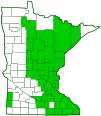American burnweed
(Erechtites hieraciifolius var. hieraciifolius)
Conservation • Wetland • Description • Habitat • Ecology • Use • Distribution • Taxonomy
Description |
||
American burnweed is a common and widespread, mildly weedy, annual forb. It occurs in the United States east of the Great Plains, in adjacent Canadian provinces, in Mexico, and in Central and South America. Its range in the United States is restricted to about the limits of the eastern deciduous forest. It is common in the eastern half of Minnesota. It grows in light shade to full sun usually in moist areas, sometimes in dry or rocky areas. It is found in woodland openings, power lines, railroads, roadside ditches, and disturbed areas. It is often one of the earliest plants to become established in recently burned sites, hence the common name. American burnweed rises usually on a single stem, sometimes two or more stems, from a taproot and tufts of fibrous roots. The stem is erect, round, 2′ to 8′ tall, and usually unbranched below the inflorescence. It is dry, not succulent, and is lined with fine vertical ridges. It may be hairless or moderately and unevenly covered with coarse, more or less spreading hairs. At the base of the stem there is a radiating group (rosette) of leaves. Basal and lower stem leaves are on short stalks (petioles) and are often withered or absent at flowering time. Stem leaves are alternate. Lower and middle leaf blades are elliptic to narrowly egg-shaped, 2⅜″ to 8″ long, and ¾″ to 3″ wide. They are tapered at the base to the petiole and tapered to a sharp point at the tip. The margins are sharply toothed and occasionally shallowly and irregularly lobed. The upper surface is hairless or has scattered coarse hairs. The lower surface is hairless to moderately hairy. The leaves become shorter, narrower, more deeply lobed, and on shorter petioles as they ascend the stem. Upper leaves are stalkless and sometimes partially surround (clasp) the stem at the base. The leaves are dry, not succulent. The inflorescence is a rounded or elongated arrangement two to twenty ⅓″ to ⅔″ long flower heads in a branched cluster (panicle) at the end of the stem and smaller panicles in the upper leaf axils. Each flower head is subtended by 1 to 6 minute, green, ascending and inward-curved modified leaves (bractlets). The whorl of bracts (involucre) at the base of the flower head is smooth, cylinder-shaped, ⅜″ to ⅝″long, 3 ⁄16″ to 5 ⁄16″wide, and conspicuously expanded at the base. It consists of usually 21 bracts (phyllaries) in two series. The outer series of 4 to 7 phyllaries are minute and entirely green. The inner series of 9 to 15 phyllaries are erect, lance-shaped to linear, flat above, and mostly green but with thin, dry margins that are not green. There are 10 to 100 outer female (pistillate) disk florets and no ray florets. The pistillate florets are ⅜″ to ⅝″long, tubular, thread-like, and whitish to pale yellow. Each one has 4 or 5 erect, triangular lobes. There are also 10 to 20 or more inner florets, most having both male and female parts (perfect), some having just male parts (staminate). The inner florets are whitish to pale yellow or pinkish, and have erect to spreading, narrowly egg-shaped lobes. The fruit is a dry, brown or purple, 1 ⁄16″ to ⅛″ long (2 to 3 mm) seed capsule (cypsela). |
||
Height |
||
2′ to 8′ |
||
Flower Color |
||
Whitish to pale yellow |
||
Similar Species |
||
|
||
Habitat |
||
Moist to dry. Woodland openings, power lines, railroads, roadside ditches, and disturbed areas. Light shade to full sun. |
||
Ecology |
||
Flowering |
||
July to October |
||
Pests and Diseases |
||
|
||
Use |
||
|
||
Distribution |
||||
|
Sources |
|||
| 2/9/2023 | ||||
Nativity |
||||
Native |
||||
Occurrence |
||||
Common and widespread |
||||
Taxonomy |
|||
| Kingdom | Plantae (Plants) | ||
| Division | Tracheophyta (Vascular Plants) | ||
| Subdivision | Spermatophytina (Seed Plants) | ||
| Class | Magnoliopsida (Dicots) | ||
Order |
Asterales (Sunflowers, Bellflowers, Fanflowers, and Allies) | ||
Family |
Asteraceae (Sunflowers, Daisies, Asters, and Allies) | ||
| Subfamily | Asteroideae | ||
| Supertribe | Senecionodae | ||
| Tribe | Senecioneae (groundsels and allies) | ||
| Subtribe | Senecioninae | ||
| Genus | Erechtites | ||
| Species | Erechtites hieraciifolius (American burnweed) | ||
Subordinate Taxa |
|||
|
|||
Synonyms |
|||
Erechtites agrestis Erechtites hieracifolius var. hieracifolius (misspelling) Erechtites hieraciifolia var. cacalioides Erechtites hieraciifolia var. hieraciifolia (misspelling?) Erechtites hieraciifolia var. intermedia Erechtites hieraciifolia var. praealta Erechtites hieraciifolius var. cacalioides Senecio cacalioides Senecio hieraciifolia Senecio hieraciifolius |
|||
Common Names |
|||
American burnweed American fireweed burnweed fireweed Malayan groundsel Pilewort |
|||
Glossary
Axil
The upper angle where a branch, stem, leaf stalk, or vein diverges.
Bract
Modified leaf at the base of a flower stalk, flower cluster, or inflorescence.
Bractlet
A small, often secondary bract within an inflorescence; a bract that is borne on a petiole instead of subtending it; bracteole.
Clasping
Describing a leaf that wholly or partly surrounds the stem but does not fuse at the base.
Cypsela
A dry, one-chambered, single-seeded seed capsule, formed from a single carpel, with the seed attached to the membranous outer layer (wall) only by the seed stalk; the wall, formed from the wall of the inferior ovary and also from other tissues derived from the receptacle or hypanthium, does not split open at maturity, but relies on decay or predation to release the contents.
Floret
An individual flower in a dense cluster of flowers; or a modified flower in the flower head in the Asteraceae family and some other families. In grasses, the modified flower in a spikelet of Poaceae and some Cyperaceae with its lemma and palea.
Involucre
A whorl of bracts beneath or surrounding a flower, flower head, or flower cluster.
Panicle
A pyramidal inflorescence with a main stem and branches. Flowers on the lower, longer branches mature earlier than those on the shorter, upper ones.
Petiole
On plants: The stalk of a leaf blade or a compound leaf that attaches it to the stem. On ants and wasps: The constricted first one or two segments of the rear part of the body.
Phyllary
An individual bract within the involucre of a plant in the Asteraceae family.
Pistillate
Referring to a flower that has a female reproductive organ (pistil) but does not have male reproductive organs (stamens).
Rosette
A radiating group or cluster of leaves usually on or close to the ground.
Visitor Photos |
|||||
Share your photo of this plant. |
|||||
| This button not working for you? Simply email us at info@MinnesotaSeasons.com. Attach one or more photos and, if you like, a caption. |
|||||
Alfredo Colon |
|||||
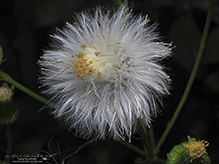 |
|||||
Luciearl |
|||||
Pilewort |
|||||
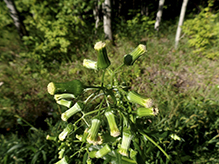 |
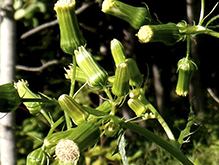 |
||||
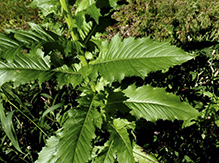 |
|||||
MinnesotaSeasons.com Photos |
|||||
|
|||||

Slideshows |
||

Visitor Videos |
|||
Share your video of this plant. |
|||
| This button not working for you? Simply email us at info@MinnesotaSeasons.com. Attach a video, a YouTube link, or a cloud storage link. |
|||
Other Videos |
|||
| Capital Naturalist: American Burnweed Capital Naturalist |
|||
About
Aug 27, 2018 This native annual goes by a variety of different common names such as American burnweed, Fireweed, and pilewort. |
|||

Created: 9/28/2019
Last Updated:
